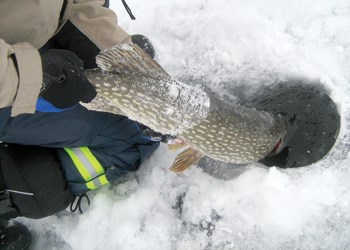There is a chill in the air as you wait on the frozen ice for that telltale sign. The line vibrates and you feel a tug as the fish takes the bait. Minutes later, the fish is out of the water and it’s time to set up your line again.
Whether with family or friends, ice fishing is a fun and popular winter activity in Saskatchewan.
It is common to see ice shacks and anglers out on the frozen waters at this time of year trying to land walleye, perch and northern pike. The sport is a great way to spend an afternoon, especially when you’re following the rules and staying safe on the ice.
Although many of the rules regarding angling remain the same between open water and ice fishing seasons, anglers should be aware of some important rules that pertain to ice fishing specifically.
“Just like the open water angling season, it is illegal to sport fish without possessing a valid Saskatchewan angling licence unless the angler is under 16 years of age or a Saskatchewan resident senior,” said Ministry of Environment Conservation Officer Rich Hildebrand. “When on the ice, anglers can drill as many holes as they like. If they make a larger hole in the ice that could be hazardous to others, it should be marked or covered when not in use for safety reasons.”
Anglers are allowed to use two lines while ice fishing, as long as they are within 25 metres of the angler and visible at all times. Up to four hooks can be used on a line; a lure with a gang of hooks is considered as one hook.
Some water bodies have been designated for angling with barbless hooks only. Also, anglers cannot possess or use a gaff longer than 1.5 metres while ice fishing, or use a spring-loaded gaff or spring-loaded hook.
Saskatchewan’s ice angling season closes on March 31 in the southern and central fisheries management zones and on April 15 in the northern management zone.
However, certain waters that are stocked with non-native trout are open to fishing year-round. Hildebrand said anglers should check the Ministry of Environment Anglers’ Guide to see if the specific water they intend to fish is open and for additional information on the rules and regulations. The guide is available at all ministry field offices and at saskatchewan.ca/fishing.
“Anglers are also reminded that the province is offering a winter free-fishing weekend in association with the Family Day holiday in February,” Hildebrand said. “From February 14 to 16 anyone will be able to angle without a licence in Saskatchewan. All other angling rules will apply and anyone transporting fish out of province must purchase an angling licence.”
As the temperatures start to warm up with the approach of spring, ice safety should always be top of mind for anglers.
“Before going out on the ice, make sure there is sufficient ice for your safety and the safety of those with you,” explained Hildebrand. “The ice should be at least 10 cm thick for a person to safely walk on, at least 20 cm thick to snowmobile on and at least 30 cm thick to drive a light vehicle on.”
Ice thickness can sometimes vary from safe to unsafe ice within a very short distance. Ice strength should never be judged by appearance alone. The ice thickness is seldom uniform throughout a water body and slush indicates that ice is eroding from above and below at an advanced rate.
Colour can be an indicator of ice strength. Blue ice is the strongest, while white/opaque ice is a mixture of ice, snow, bubbles and is much weaker than blue ice.
Hildebrand also reminds anglers that if they use an ice shelter, there are some rules they should keep in mind.
“When left out on the ice, ice fishing shelters must have the owner’s complete name, address and phone number on the outside in legible letters that are at least 2.5 cm high,” Hildebrand noted. “And, remember, it’s against the law to have alcohol in an ice fishing shelter or while fishing outside a shelter.”
Ice fishing shacks south of Highway 16 must be off the ice by March 15, and shelters north of Highway 16 must be removed by March 31. However, if the weather turns warm a conservation officer may ask the owners to remove them earlier for safety reasons.
“These shelters need to be removed because they can pose a danger to boaters, water-skiers and other users if they remain floating in the water. The pieces wash up on shore and can cause environmental hazards,” said Hildebrand.
When removing your ice shack, it is important to clean-up all litter, including fish entrails.
If shelters are not removed, owners could be prosecuted, and the structure and contents may be confiscated and removed by the ministry. In 2014, a Saskatoon man was fined $2,800 for leaving an unmarked ice fishing shelter unattended on the ice-covered waters of Blackstrap Lake, and for littering.
Ice fishing can be a very fun and pleasurable experience if it is done safely. The Ministry of Environment encourages everyone to obey the rules and be safe out there. Anyone observing fisheries or other resource violations can call our toll-free Turn-In-Poachers (TIP) hotline at 1-800-667-7561 or #5555 for SaskTel cell phone subscribers 24 hours a day to report the violations.




